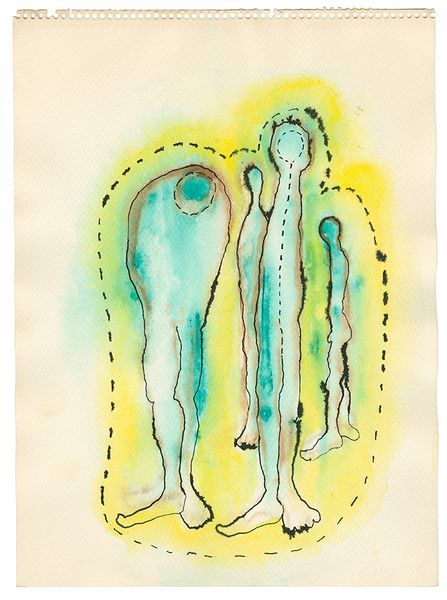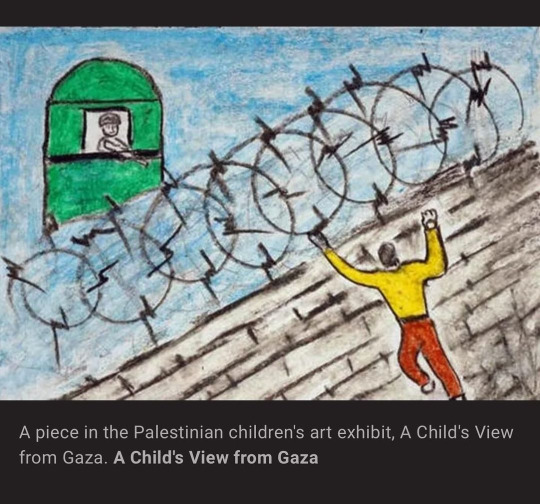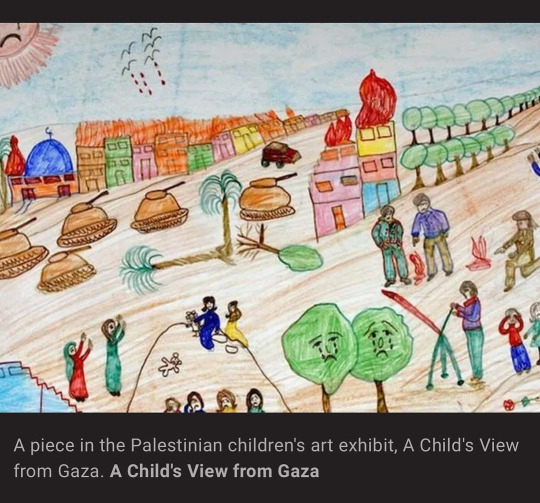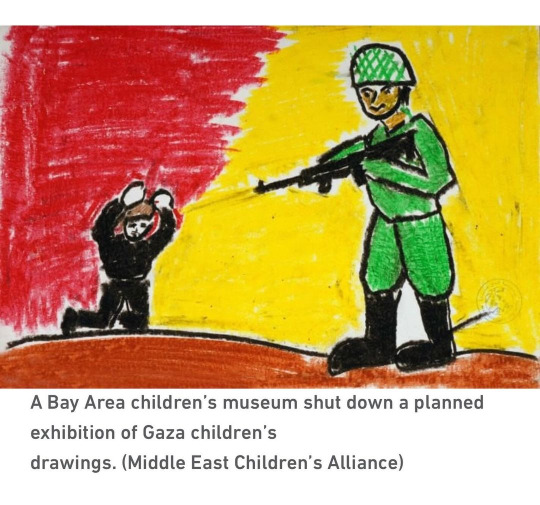A home for the exhibitions I wish I could curate and the essays I wish I could publish
Don't wanna be here? Send us removal request.
Photo

Ida Applebroog, Mercy Hospital, 1969, watercolor and ink on paper, 38.1 x 27.9 cm / 15 x 11 in
82 notes
·
View notes
Text
"A Child’s View from Gaza" was an art exhibition showcasing drawings created by the children of Gaza.







"The captioned illustrations were created by Palestinian children who lived through the Israeli bombardment of Gaza in 2008-09. The pictures were drawn as part of an effort to help children deal with the horrors they had experienced. A Bay Area nonprofit, Middle East Children’s Alliance (MECA), arranged to display a collection of these pictures at the Museum of Children’s Art in Oakland, California. However, under pressure from the Jewish Federation of the East Bay and other organizations, the museum backed out of the agreement at the last minute."
74K notes
·
View notes
Text
Social Media Massacre: The Cyberbullying Epidemic
The documentary Me at the Zoo, an almost biographical into one of the Internet’s most well-known names, Chris Crocker, touches on many aspects of the current generation’s social media landscape. One theme I noticed throughout the journey of Chris Crocker, though the documentary doesn’t go too deep into it, is cyberbullying. Cyberbullying is bullying through the use of electronic communication, and is something that has become almost epidemic among Internet users of the day what with the rise of social media. Through the protection of a screen, cyberbullies can say whatever they want to whoever they want, but it is all too often the little people who face the most backlash. As many may guess, it is the youth of today that face the most cyberbullying. Teens have more contact to the Internet than ever before, with “nearly three-quarters of teens having or having access to a smartphone and 30% having a basic phone,” according to a Pew Research study. The center also reports that, as of 2015, “92% of teen report going online daily”, with 24% saying their online “almost constantly”. With these statistics, the foundations are laid for teens and young adults to be among the most targeted demographic for cyberbullying. The Cyberbullying Research Center’s most recent data, from 2016, over a third, approximately 34%, of students reported experiencing cyberbullying within their lifetime. An additional 26% reported being cyberbullied within the last 30 days.
These statistics would be worrying to any one, parent or not, but the data worsens when you look at the figures for minorities such as people of color or LGBTQ+ teens. According to the aforementioned Pew study, “African-American and Hispanic youth report more frequent Internet use than white teens,” with 34% of African-American reporting near constant use and 32% among Hispanic teens, compared to the 19% of white teens. African-American teens are also the most likely of any group of teens to have a smartphone, with 85% having access to one, compared with 71% of among both white and Hispanic teens. This increase in access and use alone make youth of color much more susceptible to cyberbullying. In a study done by a University of Arizona professor, Sheri Bauman, she found “black students reported the highest level of cyberbullying activity at 10.9%” within her sample, followed by 9.6% among Hispanic students. White students were found to report cyberbullying at 6.7%.
We see similar targeted cyberbullying among LGBTQIA+ youth, the same group to which Chris Crocker identified, with the statistics found within a Gay, Lesbian, & Straight Education Network (GLSEN) study. According to this study, nearly half, 42%, of LGBTQ+ youth report being cyberbullied, a rate three times that of their straight, cis counterparts. One in four LGBTQ+ youth report being cyberbullied with specific reference to their gender identity or sexual orientation. We also see the sexualization of LGBTQ+ members come into play with a third of youth having experience sexual harassment online, four times as many as their straight, cis peers. As we can see, cyberbullying is a pervasive and widespread problem, and one that targets those who society already targets enough. This is one among many problems our generation and those beyond us must face up to and solve when discussing the dangers of the new Internet age and social media world.
youtube
0 notes
Text
Miss Fortune: Women’s Achievements and Advancements Within a Sexist Society
All too often, especially in our current political landscape, we are forced to face day after day of bad news showcasing the horrors, injustice, and inequality of the world. It is important to take in the facts, to allow them to motivate us to do better and be better. It is in this way that Jennifer Newsom’s look into the inequalities between men and women in her documentary Miss Representation could be useful to anyone who watches it. It is a cinematic treasure trove of information on how women’s lives could be improved upon within our existing social structures and institutions. However, it was not too long ago that women did not even have the right to vote. Our society in many ways has become one of a more egalitarian view among the privileges of men and women. Since we need only to turn on the news to see any number of ways in which our society is arguably devolving, and since, after a while, this becomes a bit depressing and tiresome, I’ve decided to showcase some of the good news. Let us begin with the aforementioned right of voting. It’s been nearly 100 years since white women gained suffrage and only a mere 52 years since the Voting Rights Act of 1965 granted people of color the right to vote, and in those years women have not taken this right for granted. According to research, the percentage eligible adults who reported voting was higher for women than men in nearly all age categories. Findings also indicate that every election year since 1980 has seen higher voter registration among women than among men. This only touches the political sphere, though. We can find women improving upon and within other industries as well. In the documentary, filmed only 6 years ago, there is this idea presented that films by and/or about women could never make as much as those by and/or about men because men simply weren’t interested in those kinds of stories. However, we have already seen this proven false in the six-year gap between this documentary’s creation and now. Just this year Marvel’s Wonder Women, directed by a woman and who’s main character is, of course, a woman, was the highest grossing film of the summer and the second highest grossing film of 2017, surpassing some of its more male-centric comic book counterparts such as Spider-Man and Guardians of the Galaxy. Arguably, these could seem like somewhat superficial ways in which women are breaking the glass ceilings needed to reach equality with men. Men are still dominating politics, men are still dominating the big screen, in front of and behind the camera. But there are other improvements which I feel cannot be minimized. A little over twenty years ago, thanks much in part to the protestations and determination of women, the National Crime Victimization Survey was redesigned in order to better detect cases of sexual assault. This has led to an increase of women coming forward with their stories which is an improvement in and of itself. However with an improvement in the accuracy of cases reported we also see more accurate data on the prevalence of such crimes and the results are dramatic. According to data from 2013, adjusted for population changes, cases of rape have dropped 55% within the space of one generation, or two decades. It is my hope that by looking into our achievements as a society, we will not feel quite so hopeless in improving upon it further. At times it can seem like nothing is being done, like we are stagnant, if not going backwards, but if we recognize the problems and see that they are able to be fixed, we might see a student writing a response to this documentary in five years’ time with even more dramatic advancements to speak of.
youtube
0 notes
Text
Class Acts: Erasure of Minority Tensions within Class-Focused Media
Pepi Leistyna’s documentary, titled Class Dismissed: How TV Frames the Working Class, discusses a variety of family sitcoms in which a character or characters’ class are discussed and examines how the diverse levels of class of these characters reflect a larger message of the real life working class and how they are viewed within society at the time. Leistyna touches on characters from a multitude of races, sexualities, and/or genders and mentions how the inclusion of diverse characters shown as members of a higher class within popular culture tended to erase the real life problems these minority groups were facing from the minds of the viewers. During a time of a fight for civil rights for people of color and equality for women, the very class structures and limitations the actors were acting out as unproblematic were affecting the lives of those outside of the tv screen.
I argue that, despite an improvement in the legal, political, and institutional struggles minority groups face within our more modern society, this problem posited by Leistyna has persisted where societal prejudice could not. The showcasing of people of color, women, and/or LGBTQ+ characters put into any class within media still creates an erasure on the real life problems these minority groups face. First, let’s examine women’s class roles within current popular culture. Some common tropes we see today are the Trophy Wife, a young woman who is often married to a rich man who uses her beauty as his own status symbol just as she uses his wealth for hers, for example, Jane Siegel Sterling from Mad Men, or the Single Mom, usually struggling financially but happy to work hard if it means she’s doing it for her kids, for example Lorelai from Gilmore Girls. These tropes are not only reductive to women as a whole, but also to the class structure they portray themselves to be a part of. Despite wildly different income brackets, two actresses acting out these two tropes within the same show may be shown as living in similar economic situations, the latter often may not even be shown struggling, but rather quite cheerful, her economic struggle being more of a symbolic sign that she is a good mother to her kids than it is any message on class inequality. And of course, I’ve yet to see a show in which these tropes are paired with a discussion on gender pay inequity, as Leistyna also points outs.
The problem persists for LGBTQ+ characters. All too often, you see shows portray same-sex couples as comfortably middle class, if not relatively wealthy, due to their lack of children. More often, the class struggle of LGBTQ+ characters is not discussed at all, favored instead is a hyper-focus on the intricacies of these characters’ sexualities. All this blatantly ignores common class tensions among members of this minority group. According to a survey, 40% of homeless use are LGBTQ+ because they face a higher risk of being kicked out of their homes. There are also states in which it is still legal to not hire someone based on their sexuality and/or gender identity. But these economic struggles are overlooked in shows’ attempts to be inclusive.
Lastly, people of color’s economic tensions face erasure by class-focused media much in the same way it did during the time of Leistyna’s documentary first coming out. Though there are more shows than ever featuring an array of classes among groups of people of color, such as Orange is the New Black, and some in which class is actually directly discussed, such as in Black-ish, its immersion in popular culture can at times seem to be having an opposite effect. It seems as though the frequent discussion of class among minority groups within popular culture has led to many people becoming complacent in it. Once they feel informed on a topic, they no longer feel as though they have to fight it, and isn’t the fact that its being discussed on tv doing enough?
Simply, my answer is the same as Leistyna: no. We have improved upon the class ideas of 90s sitcoms, and tv as a whole is significantly more diverse. However, there is still work to be done and improvements to be made. We can do better than create erasure for groups which already face so much.
youtube
0 notes
Video
Though Generation Like does a deep dive into the relationship between young people’s social media usage and their potential for increased reception to marketing. I am not here to argue whether this relationship exists, because I have no doubt it does, but rather I argue that many adults from older generations fundamentally misunderstand how millennial-aged and younger people use social media. As the documentary opens, we are almost immediately shown this meeting between the narrator and the parents, in which the parents are asking all sorts of questions about their children’s social media usage, right away showcasing their lack of use of social media and the lack of knowledge many parents have on this broad subject. Click here for research on cross-generational social media usage. From there, the usual assumptions of what kids do on social media begins. We cut from a large group of friends passionately discussing how to get more likes on Facebook. Now I will not be one to deny the desire to get more likes on a certain post or tweet. Most people contain this desire on some level, but when you hear adults discuss it, it sounds manic or obsessive. Too often, in Generation Like included, it is shown as though millennials are desperate for likes, and that these likes somehow give our posts, or even us, meaning or worth. This is simply not the case. For many, the desire for likes doesn’t go beyond a simple hope that people will think your tweet is funny. The documentary continues on to show us Ceili, a girl who likes of The Hunger Games. Her notice goes beyond mere interest though. She is a member of the fandom, the group of the most passionate fans. She competes online to gain followers and notoriety, and notes a feeling of empowerment from her online community. The documentary treats this as though it is the norm, when it is not. Most people my age will like a film, maybe send out a post or two commentating on the film and then they will let it go, leave others to form their own opinions, post their own thoughts. Ceili’s segment is followed by a montage of teens telling us why they use social media, and I find it more true to life than the entirety of the film. You hear, “It gives me a voice,” “It allows me to showcase my talent,” “You can post whatever you’re feeling…There is no one there to say, ‘Oh, you can’t say that!” Children and teens find social media empowering not because they get to collect likes like stamps or so they can show off that they are the biggest fan of the hottest new movie, but because we feel like there is nowhere else we can put our voice where we are really heard, really understood and not questioned. And now this documentary comes and misunderstands even that. I believe this comes from a place of techo-pessimissim. Adults, whether it be through a lack of understanding or what, seem to have this notion that social media is toxic, or at least that it does more harm than good. Because of this, it is not so hard to believe that a misinformed documentary shown on a channel known to have a target audience of mostly adults would be so widely accepted as truth by said target audience. They do not take the time to question beyond it, so they simply accept that a hope for some retweets stems from a place of obsession and narcissism, or that an interest in a film must be fanaticism. They can leave this film with their negative stereotypes perfectly intact, and claim they have knowledge on the subject. Well, knowledge is only as good as its source. As a generation, we cannot be as easily understood because others do not allow us to be. There is always some negative spin. We must understand though, that those shown in the documentary are the exceptions, not the rules. So, when the narrator asks, “What is it that these websites allow teens to do?” at the beginning of the documentary, perhaps we should stop looking for some dark underbelly and accept millennials are not this alien species, they were just born into a different time.
Watch the video above if you wish to see examples of techno-optimism.
0 notes